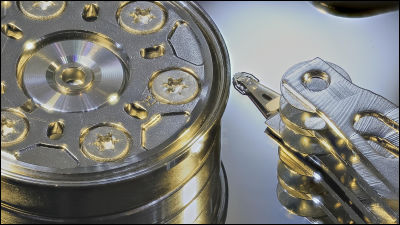Backblaze known for publishing HDD failure rate data explains the history of HDD
60 years have passed since the world's first hard disk (HDD) was born. About the HDD whose use as storage by the rise of SSD is decreasing, Backblaze which develops cloud storage service understands its history, and it explains the current state of HDD and its future on the official blog.
A History of Hard Drives
https://www.backblaze.com/blog/history-hard-drives/
The world's first HDD can be traced back to "RAMAC" released by IBM in 1956. In other words, the media called HDD is said to be a unique medium that has been active in the front lines of computing for the last 60 years. IBM's RAMAC has 50 24-inch platters (disks) built in, and the entire system is huge as large as two large refrigerators, so it was necessary to have a dedicated room to put the HDD device .

Regarding the history of the birth of RAMAC that the storage capacity was only 5 MB despite being huge, you can check it in the following article.
The world's first magnetic disk storage device (hard disk) Story till "RAMAC" is born in IBM - GIGAZINE

In response to the huge hits of RAMAC, IBM said customers' voice to increase HDD capacity and downsize was received. And it was introduced in 1962 as "IBM 1311It was a disk drive called. The platter that was 24 inch in RAMAC was reduced to 14 inch size in the IBM 1311, and the size of the entire system was downsized to the extent of the washing machine. Each disk pack was able to save 2MB files.

Even after that, the evolution of the HDD system with larger capacity and miniaturization continued. Peter Coen of Backblaze remembers seeing a removable HDD of a size like a birthday cake when he visited IBM's data center as a child. Mainframe computers announced by IBM in 1964 "System / 360"From the high popularity of the next series including IBM, HDD device connection standardized, third-party HDDs are to be born one after another.
Until the 1970s computers were very expensive, special equipment used by large corporations, universities, government agencies and others. However, due to price declines in memory chips and other electronic components, a field called "personal computer" was born. By the way, it was paper tape and punch card which was used as the memory device of the initial personal computer, and capacity was extremely small. After that, the punch card was replaced by a floppy disk, and in the 1980's HDD was adopted also for personal computer.

In 1980, Shugart Technology, a start-up company, launched a 5.25-inch HDD with a capacity of 5 MB for $ 1,500 (about 340,000 yen at that rate). Shugart Technology which gained popularity in the 1980s later changed its name to Seagate Technology. HDD size sharply decreased by the 1990's, but after that, 3.5 inch size became mainstream and miniaturization has converged.
An important event that broadens the range of applications for HDDs is the technology in which papers were published by computer scientists at the University of California at Berkeley in the late 1980sRAID"Can be cited. The idea of RAID itself seems to have been in the 1970s, but the technology that keeps redundancy by bundling generalized HDDs named RAID is indispensable for today's Backblaze service .
This is the HDD storage device "Storage Pod" that supports Backblaze's cloud service. It is said that 60 HDDs are loaded on Storage Pod about 18 cm in height to have capacity of 480 TB. It boasts 96 million times the capacity of the world's first HDD / RAMAC.

During the 1980's and 1990's, main products changed from 5.25 inch size HDD to 3.5 inch size HDD. Although there are HDDs of 2.5 inch size with notebook PC etc., the main HDD is 3.5 inch size, which has not changed for more than 20 years. While the size of the main product has not changed, the interface of the HDD is changing as IDE, SCSI, ATA, SATA, PCI Express etc. are faster and more reliable. Also, the number of revolutions of the disc has increased from 5400 rpm to 7200 rpm, which is faster, and in some products a high revolution model of 15000 rpm has also appeared.
IBM invented storage media called HDD, which has brought countless technological innovation, sold the storage division to Hitachi in 2003. In addition, Backblaze still uses HGST 's HDD that will take over genealogy of IBM.
At the beginning of 1990, the SSD cost per megabyte was 1,000 dollars (about 150,000 yen at the time), which is now sharply declining to less than 1 dollar (about 110 yen) and finally the SSD is used for general purpose But it gained popularity. The SSD, which is becoming thinner in HDD even with the unit price, has gradually replaced HDD with speed, power efficiency and high reliability.

The trend from HDD to SSD has become unstoppable, and HDD sales are also in a declining phase compared to the same period last year. However, Seagate CFO says "HDD will survive for the next fifteen to twenty years", as HDD continues to evolve technically to increase capacity, HDD will be completely destroyed to SSD for a while It is said that there is nothing. There seems to be some prediction that HDD with capacity of 100 TB will appear within 10 years.
Related Posts:
in Hardware, Posted by darkhorse_log








